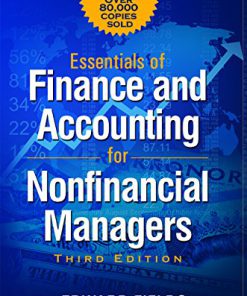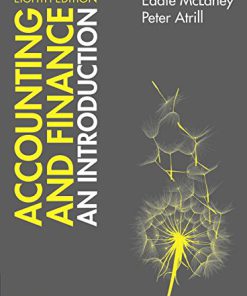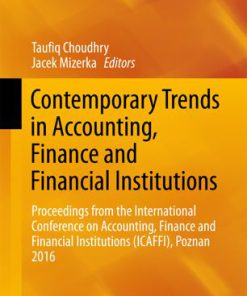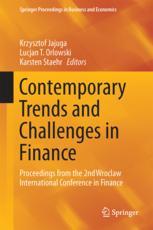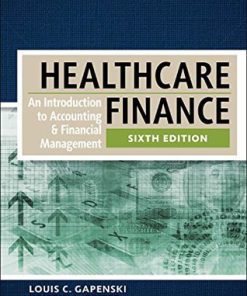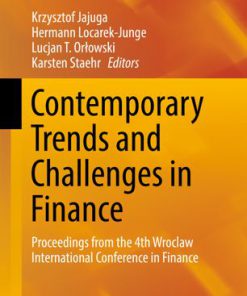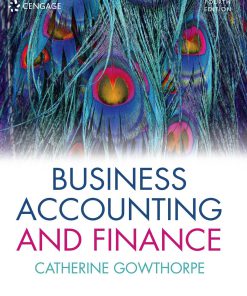New Trends in Finance and Accounting : Proceedings of the 17th Annual Conference on Finance and Accounting 1st Edition David Procházka (Eds.) 3319495593 9783319495583
$50.00 Original price was: $50.00.$25.00Current price is: $25.00.
This completed downloadable of New Trends in Finance and Accounting : Proceedings of the 17th Annual Conference on Finance and Accounting 1st Edition David Procházka
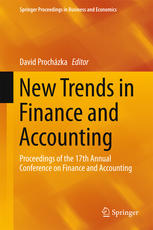
Instant downloaded New Trends in Finance and Accounting : Proceedings of the 17th Annual Conference on Finance and Accounting 1st Edition David Procházka pdf docx epub after payment.
Product details:
Table of contents:
1 The Euro Marriage
Abstract
1.1 Introduction
1.2 Broad Definition of Price Competition
1.3 Possibilities and Limitations on Calculating REERs
1.4 Price Competition in the Economy of the Czech Republic
1.5 Price Competitiveness of the Czech Industry
1.6 An International Comparison
1.7 Theory and Recommendations for Economic Policymakers
1.8 A Proposal for Rethinking the EMU Entry Criteria
1.9 Conclusion
Acknowledgments
References
2 Does Euro Introduction Ensure Lower Vulnerability of the New Euro Area Members to the External Sho
Abstract
2.1 Introduction
2.2 Literature Review
2.3 Research Methodology and Data
2.4 Research Results
2.5 Conclusion
Acknowledgments
References
3 Does Strong Employment Support Strong National Currency? An Empirical Analysis for the US Economy
Abstract
3.1 Introduction
3.2 Framework
3.3 Literature Review
3.4 Empirical Analysis
3.4.1 Data
3.4.2 Econometric Model
3.4.3 Method
3.4.4 Unit Root Tests
3.4.5 Causality Tests
3.4.6 Cointegration Test
3.4.7 Long-Term Analysis
3.4.8 Short-Term Analysis
3.5 Conclusion
Appendix
References
4 The Theory of Debt-Deflation: A Possibility of Incompatibility of Goals of Monetary Policy
Abstract
4.1 Introduction
4.2 Theoretical Exposition
4.3 Hayek’s Hypothesis of Two Rates of Interest
4.4 Conclusion
Acknowledgments
References
5 Gold Versus Stocks as an Inflationary Hedge: The Case of Spain
Abstract
5.1 Introduction
5.2 Literature Review
5.2.1 Stocks and Inflation
5.2.2 Gold and Inflation
5.3 Data and Methodology
5.3.1 Data
5.3.2 Methodology
5.3.2.1 Unit Root
5.3.2.2 Cointegration and Vector Error Correction Models (VECMs)
5.4 Empirical Results
5.4.1 Unit Root Test Results
5.4.2 Cointegration
5.4.2.1 Maki Cointegration
5.4.2.2 Vector Error Correction Model Results
5.5 Conclusion
References
6 Is There a Relation Between HDI and Economic Performances?
Abstract
6.1 Introduction
6.2 Literature Review
6.3 Methodology
6.3.1 Analytic Hierarchical Process (AHP)
6.3.2 TOPSIS
6.4 Implementation and Results
6.5 Conclusion
References
7 Foreign Capital Inflows and Stock Market Development in Turkey
Abstract
7.1 Introduction
7.2 Literature Review
7.3 Data and Econometric Methodology
7.3.1 Data
7.3.2 Econometric Methodology
7.4 Empirical Analysis
7.4.1 Unit Root Test
7.4.2 Hacker and Hatemi-J (2006) Bootstrap Causality Test
7.5 Conclusion
References
8 Count Data Modeling About Relationship Between Dubai Housing Sales Transactions and Financial Indi
Abstract
8.1 Introduction
8.2 Methods
8.2.1 Poisson Regression Model
8.2.2 Negative Binomial Regression Model
8.2.3 Zero-Inflated Regression Models
8.2.4 Hurdle Regression Models
8.2.5 Model Comparison
8.3 Application
8.3.1 Data
8.3.2 Data Analysis
8.4 Conclusion
References
9 Predictive Bankruptcy of European e-Commerce: Credit Underwriters Inexperience and Self-assessment
Abstract
9.1 Introduction
9.2 Literature Review
9.3 Data, Results, and Discussion
9.3.1 Decision Tree
9.3.2 Logistic Model
9.3.3 Discriminant Analysis
9.4 Conclusion
Acknowledgments
References
10 Cost Efficiency of European Cooperative Banks: Are Small Institutions Predestined to Fail?
Abstract
10.1 Introduction
10.2 History and Principles of Cooperative Banking in a Nutshell
10.3 Theoretical Explanation of (Dis)Economies of Scale in Cooperative Banks
10.4 Empirical Literature Overview
10.5 Analysis of European Cooperative Banks Cost Efficiency
10.6 Conclusion
Acknowledgments
References
11 The Banking Union: A View of the New Regulatory Rules
Abstract
11.1 Introduction
11.2 The Banking Union and Regulatory Rules
11.2.1 Status Quo
11.2.2 The Five Chairmen Report
11.3 Bank Recovery and Resolution Directive (BRRD): Bail-In Mechanism and MREL
11.3.1 Bail-In Mechanism
11.3.2 MREL
11.4 The Czech National Bank’s Stance to Regulatory Changes
11.5 Conclusion
Acknowledgments
References
12 Forecasting Jumps in the Intraday Foreign Exchange Rate Time Series with Hawkes Processes and Log
Abstract
12.1 Introduction
12.2 Nonparametric Jump Identification
12.3 Forecasting Jumps
12.3.1 Hawkes Process-Based Model
12.3.2 Using Logistic Regression to Model Jumps
12.4 Predicting Jumps in the EUR/USD Exchange Rate
12.4.1 Model of the Intraday Jump Seasonality
12.4.2 Modelling Jump Intensity with Hawkes Process Models
12.4.3 Modelling Jump Intensity with Logistic Regression
12.4.4 Assessing the Predictive Accuracy of the Models
12.5 Conclusion
Acknowledgments
References
13 Influence of Selected Factors on Hedge Fund Return
Abstract
13.1 Introduction
13.2 Hedge Funds
13.3 Data
13.4 Hypotheses
13.4.1 Does Hedge Fund Inclusion into Index Bring Enhanced Yield?
13.4.2 Does Optimum Hedge Fund Size Bring Additional Yield?
13.4.3 Does Higher Fee Bring Higher Return?
13.4.4 Does Hedge Fund Returns Diminish in Time?
13.5 Conclusion
References
14 Interest Rate Sensitivity of Non-maturing Bank Products
Abstract
14.1 Introduction
14.2 Interest Rate Sensitivity of Non-maturing Products—Motivation
14.2.1 Interest Rate Sensitivity of Non-maturing Liabilities
14.2.2 Interest Rate Sensitivity of Non-maturing Assets
14.3 Interest Rate Sensitivity of Non-maturing Products—Empirical Analysis
14.3.1 Empirical Analysis of Interest Rate Sensitivity of Non-maturing Liabilities
14.3.2 Empirical Analysis of Interest Rate Sensitivity of Non-maturing Assets
14.4 Conclusion
Acknowledgments
References
15 Examining the Interdependencies Between Leverage and Capital Ratios in the Banking Sector of the
Abstract
15.1 Introduction
15.2 Literature Review
15.3 Data, Results, and Discussion
15.4 Conclusion
Acknowledgments
References
16 Alternative Approaches to Insurance of Extreme Flood Risk
Abstract
16.1 Introduction
16.2 Extreme Flood Risk
16.3 Alternatives in Uninsurable Flood Risk Cover
16.3.1 Pool System of Cooperation
16.3.2 Alternative Risk Transfer Methods
16.4 Foreign Approaches to Extreme Flood Risk
16.4.1 National Flood Insurance Program
16.4.2 Flood Re
16.4.3 Natural Catastrophe Compensation System
16.5 Conclusion
Acknowledgments
References
17 Non-life Insurance Purchases of Polish Households: A Study of Leading Trends
Abstract
17.1 Introduction
17.2 Polish Non-life Insurance Market—Introductory Considerations
17.3 Contribution of Households to the Non-life Market in Poland
17.4 The Products’ Structure of Non-life Purchases by Polish Households
17.4.1 General Preferences
17.4.2 Volatility of the Products’ Structure
17.5 Conclusion
Annex
References
18 Ukrainian Exchange Returns: The Day-of-the-Week Effect
Abstract
18.1 Introduction
18.2 The Day-of-the-Week Effect: Theoretical Analysis
18.3 Literature Review
18.4 Analysis of the Ukrainian Stock Exchange Index
18.4.1 The Methodology
18.5 Results
18.6 Conclusion
Acknowledgments
References
19 Selected Passages from the Development History of Hungarian Banking Supervision in the Turn of Tw
Abstract
19.1 Introduction
19.2 Initiatives for the Establishment of Supervisory Bodies
19.3 Debates Concerning the Organisation of Supervisory Bodies
19.4 Conclusion
Acknowledgments
References
20 State Aid for Rescuing and Restructuring Firms in Difficulty and Its Impact on the State of Publi
Abstract
20.1 Introduction
20.2 Methodology of the Research
20.3 Admissibility of State Aid for Rescuing and Restructuring Undertakings in Difficulty
20.4 Does the Provision of State Aid by the EU Member States for Rescuing and Restructuring Enterpri
20.5 Conclusion
References
21 Dependence of VAT Revenues on Other Macroeconomic Indicators
Abstract
21.1 Introduction
21.2 Features of VAT
21.3 Literature Review
21.4 Analysis of Factors Affecting Value Added Tax Revenues
21.5 Conclusion
Acknowledgments
References
22 Shares in Central Government Income Taxes as a Revenues Source of Urban Municipalities in Poland
Abstract
22.1 Introduction
22.2 Research Methods, Scope, and Purpose of Work
22.3 Literature Review
22.4 Data Analysis Results
22.5 Conclusion
References
23 Can the Charitable Tax Deduction Stimulate Corporate Giving? Evidence from the Russian Banking Sy
Abstract
23.1 Introduction
23.2 Literature Review
23.3 Modeling of Corporate Giving in Russian Banking System
23.4 Results
23.5 Conclusion
Acknowledgments
References
24 The Impact of Taxation on Unemployment of University Absolvents
Abstract
24.1 Introduction
24.2 Data and Methodology
24.2.1 Selected Data
24.2.2 Analysis Methodology
24.3 Analysis Results
24.4 Conclusion
Acknowledgments
References
25 Analysis of Tax Burden in the Slovak Republic with Emphasis on Depreciation
Abstract
25.1 Introduction
25.2 Literature Review
25.3 Data, Results and Discussion
25.4 Conclusion
Acknowledgments
References
26 Fees or Taxes? The Question for the Czech Municipality
Abstract
26.1 Introduction
26.2 Financing Municipal Services—Theoretical Background
26.2.1 Financing Municipal Services—Legislative Perspective
26.3 Methodology and Data
26.4 Results and Discussion
26.5 Conclusions
Acknowledgments
References
27 Game-Theoretic Model of Principal–Agent Relationship Application in Corporate Tax Policy Design
Abstract
27.1 Introduction
27.2 Problem Statement
27.2.1 Concept Core
27.2.2 Model Framework
27.3 Computation
27.4 Conclusion
References
28 Shadow Economy in the Regions of the Russian Federation and the Ukraine
Abstract
28.1 Introduction
28.2 Measurement of Shadow Economy in Regions: Literature Review
28.3 The Model of Shadow Economy in the Regions
28.3.1 Selection of Model Indicators on the Basis of Factor Analysis
28.3.2 MIMIC Model
28.4 Results
28.5 Conclusion
Acknowledgments
References
29 Availability of Healthcare Services in Rural Areas: The Analysis of Spatial Differentiation
Abstract
29.1 Introduction
29.2 Data and Methods
29.3 Results and Discussion
29.4 Conclusions
References
30 Spatial Analysis of Turkish Voter Behaviours: Does Regional Distribution of Public Expenditures A
Abstract
30.1 Introduction
30.2 Data and Methodology
30.2.1 Spatial Analysis
30.2.2 Spatial Weight Matrix
30.2.3 Moran’s I for Global Spatial Autocorrelation
30.3 Findings and Regional Comparisons
30.4 Conclusion
Acknowledgments
References
31 Does Privatization Affect Airports Performance? A Comparative Analysis with AHP-TOPSIS and DEA
Abstract
31.1 Introduction
31.2 Methodology
31.3 Implementation
31.3.1 TOPSIS
31.3.2 Data Envelopment Analysis
31.4 Conclusion
References
32 An Empirical Analysis of Post-contractual Behaviour Regarding Public Contracts for Construction W
Abstract
32.1 Introduction
32.2 Basis of the Analysis
32.3 Data and Methods
32.3.1 Response Variables
32.3.2 Explanatory Variables
32.4 Results
32.5 Discussion
32.6 Conclusion
References
33 Reasons for Differences in European Financial Reporting
Abstract
33.1 Introduction
33.2 Literature Review
33.3 Results and Discussion
33.4 Conclusion
Acknowledgments
References
34 Forced IFRS Adoption: Direction of the “EU-15 Parents—CEE Subsidiaries” Links
Abstract
34.1 Introduction
34.2 Literature Review
34.3 Data, Results, and Discussion
34.4 Conclusion
Acknowledgments
References
35 The IFRS Adoption by BRICS Countries: A Comparative Analysis
Abstract
35.1 Introduction
35.2 Literature Review
35.3 Data, Results, and Discussion
35.3.1 Modern Accounting in Russia
35.3.2 Modern Accounting in Brazil
35.3.3 Modern Accounting in India
35.4 Conclusion
Acknowledgments
References
36 Intangibles Disclosure: Evidence from Annual Reports of the Jordanian Industrial Public Listed Co
Abstract
36.1 Introduction
36.2 Literature Review
36.3 Research Design, Sample and Data
36.4 Results and Discussion
36.5 Conclusion
Acknowledgments
References
37 Specifics of Accounting in the Agricultural Sector
Abstract
37.1 Introduction
37.2 Literature Review
37.2.1 Forms of Accounting
37.2.2 Workers in Accounting
37.2.3 Functions of Accounting
37.2.4 Individual Areas of Accounting
37.3 Methods
37.3.1 Determining the Basic and Sample Sets
37.3.2 Data Collection Methods
37.4 Results and Discussion
37.5 Conclusion
References
38 New Legislation Concerning Cash Accounting in the Czech Republic and Comments on the Application
Abstract
38.1 Introduction
38.2 Basic Premises and Literature Review
38.3 Legislation Concerning Cash Accounting in the Czech Republic
38.3.1 Historic Context
38.3.2 Basic Principles of Legislation Concerning Cash Accounting as of 1 January 2016
38.3.2.1 Accounting Entities that May Use Cash-Basis Accounting
38.3.2.2 Accounting Books, Accounting Methods and Statements
38.4 Assessment of the New Legislation Concerning Cash Accounting in Relation to the Principle of Ca
38.5 Conclusion
Acknowledgments
References
39 Comparison of Accounting for Mergers in the Czech Republic and Poland
Abstract
39.1 Introduction and Literature Review
39.2 Accounting for Mergers in the Czech Republic
39.2.1 Accounting Methods for Mergers Based on Czech Regulation
39.2.2 Treatment of the Acquisition Difference and Merger Date in Czech Republic
39.3 Accounting for Mergers in Poland
39.3.1 Accounting Methods for Mergers Based on Acc. Act
39.3.2 Goodwill
39.4 Conclusion
Acknowledgments
References
40 The Revised Control Concept in the Consolidated Financial Statements of Czech Companies
Abstract
40.1 Introduction
40.2 Revised Control Concept
40.3 Literature Review
40.4 Data, Results and Discussion
40.5 Conclusion
Acknowledgments
References
41 Audit Market Concentration Analysis Focusing on Auditors of Public Interest Entities
Abstract
41.1 Introduction
41.2 Literature Review and Research Hypotheses Formulation
41.3 Data and Methodology
41.3.1 Data
41.3.2 Methodology
41.4 Discussion
41.5 Conclusion
Acknowledgments
References
42 Audit Committees in Corporate Governance: Selected Issues in the Czech Environment
Abstract
42.1 Introduction
42.2 Literature Review
42.3 Audit Committee
42.4 Tax Aspects of Remuneration of the Members of Audit Committees
42.4.1 Taxation of Remuneration of a Member of Audit Committee
42.4.2 Assessment of Tax Deductibility of the Remuneration of a Member of the Audit Committee
42.5 Conclusion
Acknowledgments
References
43 The Municipality Economic Review by Auditor or by Regional Authority?
Abstract
43.1 Introduction
43.2 Literature Review
43.3 Economic Review
43.3.1 Term
43.3.2 Legislation
43.3.3 The Economic Review by a Regional Authority
43.3.4 Economic Review by an Auditor
43.4 Statistics
43.4.1 Frequency of the Economic Review
43.4.2 Number of Errors
43.4.3 Imperfections by Acts (Regularity Audit)
43.5 Conclusion
Acknowledgments
References
44 All for One and One for All: A Cross-Sector Analysis of Reporting Standards
Abstract
44.1 Introduction
44.2 Research Methodology
44.3 A Conceptual Comparison Between Sectors
44.4 Reporting Standardization for Both Sectors: A Never-Ending Story?
44.5 Connecting the Dots: Insights and Discussion on Reporting Standards and Principles
44.6 Conclusion, Limits and Perspectives
Acknowledgments
References
45 Disclosure of Financial Information About the General Government Sector by IPSAS
Abstract
45.1 Introduction
45.2 Literature Review
45.3 Data and Methodology
45.4 Results and Discussion
45.5 Conclusion
Acknowledgments
References
46 The Comparative Analysis of CAS and IPSAS Requirements on Tangible Fixed Assets
Abstract
46.1 Introduction
46.2 Review of Literature and Background of the Paper
46.3 The Development of Public Sector Accounting Standards
46.4 Differential Analysis
46.5 Conclusion
Acknowledgments
References
47 Sustainability Reporting Versus Integrated Reporting: BIST Sustainability Index
Abstract
47.1 Introduction
47.2 Sustainability Reporting
47.3 Integrated Reporting
47.4 BIST Sustainability Index
47.4.1 BIST Sustainability Index Ground Rules
47.5 BIST Sustainability Index Inclusion Rules
47.5.1 Expected Contribution from Index
47.6 Conclusion
References
48 Management Control Systems Through the Lens of the Agency Theory
Abstract
48.1 Introduction
48.2 The Agency Theory
48.3 MCSs Through the Lens of the Agency Theory
48.4 MCS Functions Derived from the Agency Theory
48.5 Conclusion
Acknowledgments
References
49 Sustainable Controlling: Measuring Method Based on the Catalogue of Controller Tasks
Abstract
49.1 Introduction
49.2 Tasks of Modern Controlling
49.3 Sustainable Controlling
49.4 Sustainable Controlling Measures
49.5 Conclusion
References
50 Empirical Study of Approach to Sustainability Management and Reporting in the Czech and Slovak Re
Abstract
50.1 Introduction
50.2 Literature Review
50.3 Methodology
50.4 Results
50.5 Conclusion
Acknowledgments
References
51 Adoption of Strategic Management Accounting Techniques in Czech and Slovak Companies
Abstract
51.1 Introduction
51.2 Strategic Management Accounting (SMA) Techniques
51.3 Methodology of Empirical Study
51.3.1 Data Collection and Sample of Responses
51.4 Findings
51.5 Conclusions
Acknowledgments
References
52 The Use of Assessment of Work Performance of Human Resources as a Tool of Management Accounting t
Abstract
52.1 Introduction
52.2 Theoretical Background
52.2.1 Management Control System
52.2.2 Result (Output) Controls Versus Management Accounting Versus Personnel Management
52.2.3 Assessment of Work Performance of Human Resources
52.2.4 The Methods of Assessment
52.3 Paper Objective and Methodology
52.4 Results and Discussion
52.4.1 Formal Systems of Assessment
52.4.2 Dividing of Systems of Assessment According to Categories of Employees
52.4.3 An Option to React to Results of Assessment
52.4.4 Use of Gained Information from Assessment
52.5 Conclusion
Acknowledgments
References
53 Use of Management Accounting Information for the Formation of the Business Model of a Public Comp
Abstract
53.1 Introduction
53.2 Methods
53.3 Data, Results, and Discussion
53.4 Conclusion
References
54 How Demands of Donors Influence the Design of the Management Control System of Not-for-Profit Non
Abstract
54.1 Introduction
54.2 Typology of Donors
54.3 Key Management Control Parameters of Projects
54.4 Donor’s Contractual Framework
54.5 Conclusion
Acknowledgments
References
55 Actual Problems of Accounting Ensuring Asset Management at the Enterprises of Ukraine
Abstract
55.1 Introduction
55.2 The Place of Assets in an Enterprise Management System
55.3 The Accounting Valuation of Assets in the Theory and Normative Regulation
55.4 Theoretical Aspects of Estimation of Cost of Assets
55.5 Standard Regulation of Estimation of Cost of Assets
55.6 Current State of Display of Information on Assets in the Report on a Financial State
55.7 Conclusion
References
56 Direct and Indirect Influence of Information and Communication Technology on Corporate Performanc
Abstract
56.1 Introduction
56.2 Methods
56.3 Results
56.4 Discussion
56.5 Conclusion
Acknowledgments
References
57 Facility Management as a Partner of Cost Controlling at Costs Optimization in the Selected Enterp
Abstract
57.1 Introduction
57.2 Theoretical Background
57.3 Paper Aim and Methodology
57.4 Process of Reducing Heating Costs
57.5 Conclusion
Acknowledgments
References
58 Pecking Order Theory and Innovativeness of Companies
Abstract
58.1 Introduction
58.2 Literature Review
58.3 Data and Methodology
58.4 Results
58.5 Conclusion
Acknowledgments
References
59 A Compulsory Corporate Finance: Reflections on the Scope and Method
Abstract
59.1 Introduction
59.2 The Origin of the Economics of Corporate Finance Within Limits
59.3 The Roots and Fruits: The Scope of Compulsory Corporate Finance
59.4 Many Questions but One Answer: The Method of Compulsory Corporate Finance
59.5 Conclusion
Acknowledgments
References
60 Socially Responsible Investment Market Size in Poland: The Content Analysis
Abstract
60.1 Introduction
60.2 Socially Responsible Investment Market Size—Literature Review
60.3 Research Design
60.4 Results and Discussion
60.5 Conclusion
References
61 The Role of Convertible Bonds in the Corporate Financing: Polish Experience
Abstract
61.1 Introduction
61.2 Convertible Bonds as a Corporate Financing Instrument (Opportunities and Threats)
61.3 The Issuance of Convertible Debt: The Experience of Polish Companies
61.4 Conclusion
References
62 Evaluation of Investment Attractiveness of Commonwealth of Independent States
Abstract
62.1 Introduction
62.2 Literature Review
62.3 Methodology, Data and Results
62.4 Conclusion
Acknowledgments
References
63 Using Rating for Credit Risk Measurement
Abstract
63.1 Introduction
63.2 Literature Review
63.3 Data, Results and Discussion
63.4 Conclusion
Acknowledgments
References
64 Applicability of Selected Predictive Models in the Slovak Companies
Abstract
64.1 Introduction
64.2 Theoretical Background and Methodology
64.3 Data Analysis and Results
64.3.1 Results of Predictive Models
64.3.2 Results of Economic Value Added
64.3.3 Verification of Predictive Models with EVA
64.4 Conclusion
Acknowledgments
References
65 Model of Hospitals’ Financial Distress Forecasting: Comparative Study
Abstract
65.1 Introduction
65.2 Methodology and Data
65.3 Results and Discussion
65.4 Conclusions
References
66 Determinants of Long-Term and Short-Term Debt Financing: Evidence from Poland
Abstract
66.1 Introduction
66.2 Literature Review
66.2.1 Size of a Company
66.2.2 Profitability
66.2.3 Tangibility
66.2.4 Growth
66.3 Research Methodology
66.4 Results—Analysis of Long-Term and Short-Term Debt Financing Determinants
66.5 Conclusions
References
67 A Working Capital and Liquidity
Abstract
67.1 Introduction
67.2 Working Capital
67.3 Liquidity
67.4 Conclusion
Acknowledgments
References
68 Determinant Factors of Economic Value Added: Case of Ukrainian Wineries
Abstract
68.1 Introduction
68.2 Wine-Making Industry in Ukraine
68.2.1 Literature Review and Hypotheses Development
68.2.2 Results and Discussion
68.3 Conclusion
References
69 Dividend Policy of State-Owned Companies: Evidence from the Russian Federation
Abstract
69.1 Introduction
69.2 Literature Review
69.3 Emerging Capital Markets Dividend Policy
69.3.1 Dividends in Emerging Markets on the Worldwide Scale
69.3.2 The Dividend Policy of the Russian State-Owned Joint Stock Companies
69.3.3 On the Standard Dividend Payout Ratio for Russian State-Owned Joint Stock Companies
69.3.4 The Background for the Development of the Dividend Policy of Russian Joint Stock Companies
69.4 Conclusion
References
70 Personal Bankruptcy in Královéhradecký and Pardubický Regions
Abstract
70.1 Introduction
70.2 Debt Relief
70.3 Methodology
70.4 Results
70.5 Conclusion
Acknowledgments
References
71 Existence of Size Premium: A Review of Literature and Suggestions for Future Research
Abstract
71.1 Introduction
71.2 Current Knowledge and Findings
71.3 Conclusion
Acknowledgments
References
72 Invested Capital, Its Importance, and Interpretability Within Income-Based Methods for Determinin
Abstract
72.1 Introduction
72.2 The Volume of Capital Invested in Income-Based Valuation Methods
72.2.1 Discounted Free Cash Flow Method
72.2.2 Economic Value-Added Method
72.2.3 The Importance of the Volume of Invested Capital in Terms of Economic Meaningfulness and Inte
72.3 Methodology of the Problem Solving in Relation to IFRS 3
72.4 Conclusion
Acknowledgments
References
73 Constructing Czech Risk-Free Yield Curve by Nelson-Siegel and Svensson Method and Their Compariso
Abstract
73.1 Introduction
73.2 Usage of Nelson-Siegel and Svensson Methods in Foreign Praxis
73.3 Theoretical Fundamentals of the Methods
73.3.1 Nelson-Siegel Method
73.3.2 Svensson Method
73.4 Construction Czech Risk-Free Yield Curve by Nelson-Siegel and Svensson Method
73.4.1 Estimation Technique of Nelson-Siegel and Svensson Method
73.4.2 Estimation Results of Nelson-Siegel and Svensson Method
73.5 Conclusion
Acknowledgments
References
74 Discount Rate for Human Life-Related Decisions
Abstract
74.1 Introduction
74.2 Legislation
74.2.1 Cost of Sustenance of Close Persons § 2966, § 2967, § 2968
74.2.2 Compensation for Mental Harm § 2959
74.2.3 Costs of Funeral § 2961
74.2.4 Costs of Health Damage and Death § 2958
74.2.5 Methodology of the Highest Court of Czech Republic
74.2.6 Ogden Tables
74.3 Theoretical Approaches to Value of Human Life
74.3.1 Human Capital
74.3.2 Willingness to Pay
74.4 Risk-Free Discount Rate
74.5 Indicative Calculation of Discount Rate
74.6 Discount Rate Based on Risk of Death
74.7 Discussion
74.8 Conclusion
Acknowledgments
References
75 Discount Rate in Business Damage Cases
Abstract
75.1 Introduction
75.2 Basic Methodologies Used for Damage Calculation
75.3 Discounting in Business Damage Cases
75.4 Conclusion
Acknowledgments
References
76 Medical Device Price and Valuation
Abstract
76.1 Introduction
76.2 Literature Review
76.3 Data, Results, and Discussion
76.3.1 Reimbursement and Early-Stage Development Decisions: Bayesian Approach
76.3.2 Health Technology Assessment (HTA)
76.3.3 Options Valuation and Pay-for-Performance
76.3.4 Specificities of the Medical Device Market
76.4 Conclusion
Acknowledgments
References
77 Specification of Net Operating Assets for Economic Value Added Calculation from Balance Sheets Re
Abstract
77.1 Introduction
77.2 EVA and Net Operating Assets
77.3 Annual Accounts of Business Companies’ Survey Results
77.3.1 Investment Property
77.4 Companies Using Fair Value Model
77.5 Companies Using Cost Model
77.5.1 Non-current Assets Held for Sale and Discontinued Operations
77.5.2 Finance Leases
77.5.3 Goodwill
77.6 Conclusion
Acknowledgments
References
78 Agricultural Land Valuation and Capitalization Ratio
Abstract
78.1 Introduction
78.2 Basic Three Methods for Land Valuation
78.3 Agricultural Land Valuation
78.4 Problems on Determination of the Agricultural Land Values by Using Income Approach
78.5 Conclusion
People also search:
what is the future of accounting and finance
a new trend for the future is quizlet
current trends in accounting profession
industry trends in accounting
current trends in accounting profession
You may also like…
Business & Economics - Mathematical Economics
The Essentials of Finance and Accounting for Nonfinancial Managers, Third Edition Edward Fields
Business & Economics - Accounting
Accounting and Finance: An Introduction 8th Edition Eddie Mclaney
Science (General) - International Conferences and Symposiums
Business & Economics
Ethics and Sustainability in Accounting and Finance, Volume I Kıymet Tunca Çalıyurt
Business & Economics
Business & Economics - Accounting
Business Accounting and Finance 4th Edition by Catherine Gowthorpe ISBN 9781473749351 1473749352




